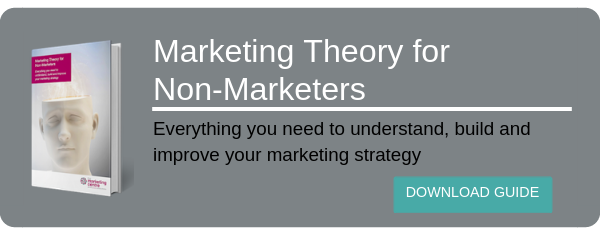Warren Buffett, as one of the richest men in the USA, knows a thing or twenty-nine about making money. His core rules include “Never lose money”, “Keep doing the same things and you keep getting the same results”, and, most importantly for us, “Never invest in something you cannot understand”.
That last point absolutely applies to marketing. Many business leaders don’t entirely understand marketing. They know it has to be done, but not how - or how much it should cost. To pick one example, related to one marketing medium: a survey by MDG reveals that 44% of Chief Marketing Officers are unable to measure the impact of social media on their business at all, while only 20% say they can quantify that impact. And yet 73% of businesses are tracking their social media efforts - so what’s going wrong between the monitoring and the understanding?
The truth is, tracking your efforts doesn’t mean you understand them. Too many businesses dwell on vanity metrics that indicate marketing activity is happening, but don’t relate it to a palpable goal.
Return On Investment is the bedrock of a sensible, viable marketing strategy. How much are you spending on marketing, and how much is it benefitting your business at the bottom line? If you’re not crystal clear about what’s working and what’s not, you’re almost certainly wasting your business’ time and money on marketing activities that don’t pay off.
ROI needs to be measured, and it needs to be measured against a plan. You need to know upfront what your marketing activities are meant to achieve and what practical, measurable business goals they’re intended to deliver on. You’ll need to set targets, and understand what kind of results are and aren’t worth your money.
Shortcuts
- What is ROI, and why does it matter?
- Two metrics every business should be tracking
- Which digital analytics to include in your marketing report
- Why digital metrics aren't the be-all and end-all of marketing
- How to make sure your marketing consultant understands ROI
- Conclusion
What is ROI, and why does it matter?
Return On Investment is the backbone of successful business leadership. What are you spending, and on what activities, and how much profit is that making you?
It’s easy to lose sight of what your marketing spend is doing for your bottom line. Marketing consultants and agencies often justify their work with ‘vanity stats’ - Facebook views, shares, influential followers - that sound terribly impressive, but don’t amount to actual business performance. There’s no profit: no Return On Investment.
Our definition of marketing ROI starts with the ‘R’ and works back to the ‘I’.
A five-year contract worth £200k a year offers a Customer Lifetime Value (CLV) of £1 million. Spending £100k in the first year to win that client? That’s good ROI - your investment has paid off tenfold. Now make it a one year contract, and you’re only getting back twice what you spend. The R isn’t worth the I.
- You may like: Brand building: what's it all about?
Of course, this isn’t as simple as it sounds. There’s seldom a direct one-to-one relationship between a single marketing activity and a single sale, and tracing the exact influence of all your marketing channels, messages and processes on each converted customer is quite a challenge.
Calculating the necessary investment in each of your customers means establishing the journey they take to reach you. They won’t all take the same steps, but there will always be commonalities - customers who’ve come to you along a similar route. Then, you can make your way back along that route from the point of conversion, and look at the number of customers who didn’t convert along the way.

By way of an example, here’s a digital marketing journey, modelled in reverse. How many leads do you need to generate one sale? How many contacts do you need to gather to generate a lead? How much web traffic do you need to generate that many contacts? How much content do you need to publish to attract that much traffic? How much will it cost you - in agency fees, or in-house labour hours paid for - to create that content?
The answers to those questions will link the lifetime value of that one customer to the total you spent on securing them: and that’s your ROI.
What justifies your marketing spend? The measurable gain in profit that can be traced back to it. To make your marketing spend work for you, you need to know what is working, what isn’t, and why. To do that, you’ll need two things. Appropriate metrics - things to measure - and a system for measuring them.
Marketing dashboards and ROI reports
A marketing campaign should always end with a final ROI report, but you need to monitor performance regularly while the campaign is in progress, so you can make changes where needed. A three-month campaign will benefit from reporting at least once a month; a two-week campaign needs monitoring daily, because there’s less time in which to meet the goals.
You monitor marketing performance with a marketing dashboard - something that compiles the most relevant statistics from your marketing and reports back on the results; a must-have for tracking and improving your marketing activity.
The dashboard includes both your ROI and the figures that will help you calculate it. The budget and output calculation that shows your ROI sits next to retention - how many of those customers stay with you once converted. These two figures are your fuel gauge and your speedometer - they tell you how well you’re doing and how long you can sustain it.

Around those are the other ‘dials’ - the metrics which relate to the customer journey you’re tracking. These will vary depending on your current business goals. For digital marketing campaigns, you’ll be interested in clickthrough rates on the content that brings most of your converting customers in: for telephone marketing campaigns, you’ll be counting calls made, decision makers contacted and sales appointments booked. Your dashboard can also include pipeline metrics - if your customers are moving along a predictable path of lead generation, track how many you have at each point to find any blockages in the pipe.
However, there are two metrics which every business should be tracking: two benchmark figures that relate directly to investment and return, and are vital in understanding and managing your ROI.
Two metrics every business should be tracking
There are many, many marketing metrics in the world. Some of them can’t be measured, some of them shouldn’t be (at least, not as a matter of course), but two marketing metrics are essential for any business.
These two metrics - marketing as a percentage of sales and cost per acquisition - directly link inputs with outputs, showing how the marketing cash invested compares to the sales cash returned.
Marketing as a percentage of sales
To calculate marketing as a percentage of sales, divide the amount of sales income by the amount of marketing spend.
Make sure you include the indirect costs of your marketing, including labour hours. It may cost £12,000 to attend a trade show, but it’ll amount to more after you’ve built the stand and pulled five team members out of the field to staff it for three days.
Otherwise, the calculation is that simple. Making something of it - deciding how much is enough - is a little harder.
For B2B business, the sweet spot is between 4% and 8%. If your marketing spend is less than 1% of sales, you either have a monopoly or you’re missing opportunities. If it’s more than 10%, chances are your marketing activities are inefficient - there’s something in the mix that isn’t generating returns.
For B2C, the ideal marketing spend is variable, and may be higher. In the first year or two of a business’ operations, it may spend 25% of its sales income on marketing and building up a brand, before cutting back to 20% as particular channels are wound down and approaches refined.
Making those choices is where the second key metric comes in.
Cost per acquisition
To calculate Cost Per Acquisition (CPA), divide your total marketing budget by the number of new customers acquired.
You might calculate CPA:
-
over a particular period - how much did you spend to acquire how many customers in a week, month or quarter?
-
by channel - what are you spending on telephone marketing and how many sales are you making on the calls?
-
by project - how much is a particular campaign costing and how many new customers mention it in their post-sale surveys?
This kind of breakdown helps you establish how your customers get to you. It also establishes where you’re spending more than you’re making.
B2C businesses often have a low target CPA, with margins of acceptable spend measured in single figures. The difference between £6 and £7 adds up when you’re dealing with millions of potential customers, after all.
In B2B marketing, on the other hand, there’s a wider range of possibilities. For a professional service delivered over several years, the CPA benchmark might be close to £1000; a new account for a simple but repeatable offering delivered several times might be closer to £100; a one-off transactional product may sit at £10.
Marketing as a percentage of sales and cost per acquisition are essential marketing metrics for any business - but they’re not the be-all and end-all of a marketing report. If you’re working on a range of digital channels - as a majority of businesses will be - you also need to think about which digital analytics will reveal something useful about your marketing efforts, and which ones you can afford to ignore.
Which digital analytics to include in your marketing report
Digital marketing is marketing delivered through digital channels. As a term, it covers Search Engine Optimisation (SEO), websites, social media, email newsletters and apps. Digital analytics are the processes that track all this activity.
Crucially, digital techniques often demand digital specialisation - from people who aren’t marketers, or strategists, and view their activities on their own terms. If they’ve got you the views, the likes and the shares, their job is done: they’re not thinking in terms of money spent, money earned, or how their activity impacts the business’ bottom line. Many of these digital specialists will tell you that you can’t measure ROI on their work without expensive, all-encompassing software, and you need to trust their claims about reach and engagement.
They’re wrong. Digital marketing ROI is measurable.
The two key metrics we’ve already discussed - marketing as a percentage of sales and CPA by channel - will give you ballpark figures, which should be relatively low in comparison to revenue.
It’s also worth looking at customer retention metrics. Your existing customers are a safer bet - you have a 60-70% chance of selling to an existing customer, compared to 5% for a totally fresh customer journey - and therefore you need to think about them.
The three metrics worth tracking here are:
-
Customer lifetime value - the average amount each customer spends during the average amount of time they spend with you.
-
Churn rate - the number of customers who stop buying each month, divided by the number of new customers.
-
Customer retention cost - the amount you spent on retention activities, divided by the number of customers successfully retained, which should sit at about 33% of your overall marketing budget.
These will indicate the cash value, over time, of every customer who you can confirm was converted by digital marketing activities.
However, the real key to measuring your digital marketing ROI is focusing on goals over activity. Eliminate the numbers that don’t address the bottom line. Web visits, conversions, clickthroughs and open rates have their place in establishing the customer journey, and marketing directors should have access to this data, but they need to prioritise the metrics that align with their marketing goals.

If you have an established inbound marketing strategy, then bounce rate - the percentage of visitors to the site who only view one page - might simply be a vanity metric. For a business working hard to increase their online sales potential, however, bounce rate is vitally important, because it shows you how and where you’re losing customers before conversion.
Here are some other digital marketing goals - and the key metrics to track for each one.
-
To generate more leads via inbound channels, track how effectively channels drive traffic to the website. Whether organic search, social advertising, paid search or PPC perform should affect decisions about ongoing marketing activity.
-
To increase your number of overseas sales, track the location of website visits. This will indicate markets worth spending more marketing budget in.
-
To improve how you use content to encourage sales conversations, track web goals. Businesses offering an ebook or white paper should track conversions via their download page, for example.
-
To drive more sales via e-commerce, track online sales. This will indicate products or product ranges worth expanding or retiring.
-
To make the website work harder, track conversion rates. It’s less important for a business owner to know how each minor change made to a website affects its performance. More important is that they can see a trend of improvement, and understand that their investment in their website is working.
Digital marketing needs digital metrics - you need some way of establishing how each channel is performing in terms of your goals in using it. However, analytic data isn’t the be all and end all. There are aspects of marketing which can’t be measured by quantitative methods. Numbers aren’t all you need...
Why digital metrics aren't the be-all and end-all of marketing
Data is enormously valuable to marketers. We’ve never been able to collect as much information on customers, clients, prospects, leads and conversions as we can now. However - and this is a crucial point - data doesn’t tell us everything about our marketing performance.
Quantitative data - data that can be expressed in pure numbers - can tell us how many prospects convert at each point in the customer journey, but not why. Purchase decisions are driven by attitude, belief and perceived need, none of which can be directly measured in numerical terms.
Similarly, there’s no hard and fast metric for brand awareness - but it’s an integral factor in conversion rates, customer lifetime value and average order sizes. And there’s no way to directly measure the impact of visibility - who’s seen to be associated with your brand.
Relying on pure quantitative data, acquired at the point of collection, risks losing sight of an essential step in the customer journey. If your customers are buying from your own website, it’s easy to assume that the website is what’s converting, and to allocate more spend to web development as a result.
What you may not know is that they’re coming to the website because they have a positive opinion toward your brand that’s generated from a sponsored video on YouTube - something you made for a campaign two years ago that’s still generating awareness and positive associations.

By the time the customer has arrived at your website, they may have forgotten that the video was yours, they may not mention it at a point of sale survey, but it was integral in their journey toward conversion - and your raw data will not reflect this at all.
An integrated marketing strategy goes beyond raw data, recognising that different tools do different things and generate broader, deeper end results. The customer journey operates more smoothly when marketers mix media and create a range of emotions and touchpoints. Data is vital for making informed decisions, but never underestimate the power of the marketing efforts that can’t be measured on a spreadsheet.
Good marketing specialists, directors and consultants understand this. But how do you spot the ones who don’t?
How to make sure your marketing consultant understands ROI
Not all marketing consultants are created equal. Some, when confronted with a difficult question like “yes, but how much money are you making us?”, tend to equivocate, falling back on easy claims - big names and numbers - to ‘prove’ their effectiveness.
“Look at the website hits”, they’ll say, or “well, four big influencers retweeted us”. These are vanity metrics. They sound good, but they don’t prove anything about actual business growth or profitability. There are five key questions you need to ask your marketing leaders at the hiring stage, so you don’t end up taking on a marketing consultant who’s not up to the job.
-
How do you calculate and demonstrate ROI? If they can’t provide a methodology for breaking down ROI - the calculations they use and the structure of their marketing dashboard - they’re an accident waiting to happen. ROI can be complex, but it shouldn’t be a total mystery.
-
How much budget do you need for marketing? This is a trick question. What you’re really after is their marketing plan. If they don’t talk about a wider strategy, and come in with a specific figure straight away (or worse, “how much have you got?”), they might not be quite fit for purpose.
-
What’s our CPA? Don’t say Cost Per Acquisition. Use the acronym, and see if they recognise it. A competent marketing professional should know this term, ask you for the figures, and make the calculation. It’s that fundamental to your marketing strategy that it should make or break a hire: after all, it’s going to be implicated in every marketing decision you make.
-
What’s our CLTV? Again, this is an opportunity for your marketing hire to show their quality. Any marketer worth their salt should immediately ask for the average customer spend, the average customer lifespan, and multiply them together to find the Customer Lifetime Value.
-
Where should I be spending money? If you’re checking up on your existing marketing personnel, they should have a solid, documented marketing plan that they’re already working off, and be able to tell you not only where you’re spending, but how much you’re getting back.If you’re asking this question of a new hire, the answer should be “I think these channels might work, but we need to work out a detailed strategy.” Beware of instinctive answers - if someone says “VR!” or “social media!” or “PPC!” straight away, they’re not taking into account how your business works; they have a favourite technique and they’re hoping it works.
Return On Investment is the bedrock of your entire marketing strategy. A marketing director or consultant who’s worth hiring will know this, and will not be backward about coming forward and saying so.
Return On Investment, on the surface, is a simple enough idea. You spend money on marketing; how much are you getting back in sales?
Delivering an answer to that question is the tricky part. Once you understand your customer journey, and the points of contact they have with your business before they do business, you’ll know where to look for ROI. At every stage in that journey, you’re spending money on a marketing activity that moves customers closer to purchase - and from there you can work out how much value each of these activities is providing in terms of customers moved along.
This crucial figure - cost per acquisition - is one of the two core metrics for measuring your marketing results. The other - marketing as a percentage of sales - is a benchmark figure for your overall marketing spend, setting a target.
The other metrics you need will vary depending on your goals. Marketing activities should always be aligned to a specific business outcome, and the metrics you choose to monitor that activity should be direct measurements of your progress toward that goal.
That said, raw numbers aren’t everything. Qualitative data - the how and why factors which motivate purchase decisions - can’t be tracked in quantitative terms. Marketing directors, consultants and teams have to understand this: and they have to understand the essential processes by which you define, calculate, and improve Return On Investment.






